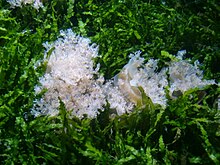| Cassiopea | |
|---|---|

| |
| Cassiopea sp. | |
| Scientific classification | |
| Domain: | Eukaryota |
| Kingdom: | Animalia |
| Phylum: | Cnidaria |
| Class: | Scyphozoa |
| Order: | Rhizostomeae |
| Family: | Cassiopeidae Agassiz, 1862 |
| Genus: | Cassiopea Péron & Lesueur, 1809 |
| Species | |
|
8 species, see text | |
| Synonyms | |

Cassiopea (upside-down jellyfish) is a genus of true jellyfish and members of the family Cassiopeidae.[3] They are found in warmer coastal regions around the world, including shallow mangrove swamps, mudflats, canals, and turtle grass flats in Florida, the Caribbean and Micronesia. The medusa usually lives upside-down on the sea floor in shallow areas, which has earned them their common name. These jellyfish partake in a symbiotic relationship with photosynthetic dinoflagellates and therefore, must lie upside-down in areas with sufficient light penetration to fuel their energy source.[4] Where found, there may be numerous individuals with varying shades of white, blue, green and brown.
- ^ IRMNG (2021). Cassiopeia Gistl, 1848. Accessed on 2023-05-29.
- ^ IRMNG (2021). Cassiopeja Schultze, 1898. Accessed on 2023-05-29.
- ^ "Cassiopeidae". WoRMS. World Register of Marine Species. Retrieved 3 August 2012.
- ^ Ohdera Aki H.; Abrams Michael J.; Ames Cheryl L.; Baker David M.; Suescún-Bolívar Luis P.; Collins Allen G.; Freeman Christopher J.; Gamero-Mora Edgar; Goulet Tamar L.; Hofmann Dietrich K.; Jaimes-Becerra Adrian; Long Paul F.; Marques Antonio C.; Miller Laura A.; Mydlarz Laura D.; Morandini Andre C.; Newkirk Casandra R.; Putri Sastia P.; Samson Julia E.; Stampar Sérgio N.; Steinworth Bailey; Templeman Michelle; Thomé Patricia E.; Vlok Marli; Woodley Cheryl M.; Wong Jane C.Y.; Martindale Mark Q.; Fitt William K.; Medina Mónica (2018). "Upside-Down but Headed in the Right Direction: Review of the Highly Versatile Cassiopea xamachana System". Frontiers in Ecology and Evolution. 6: 35. doi:10.3389/fevo.2018.00035. hdl:11449/176281.